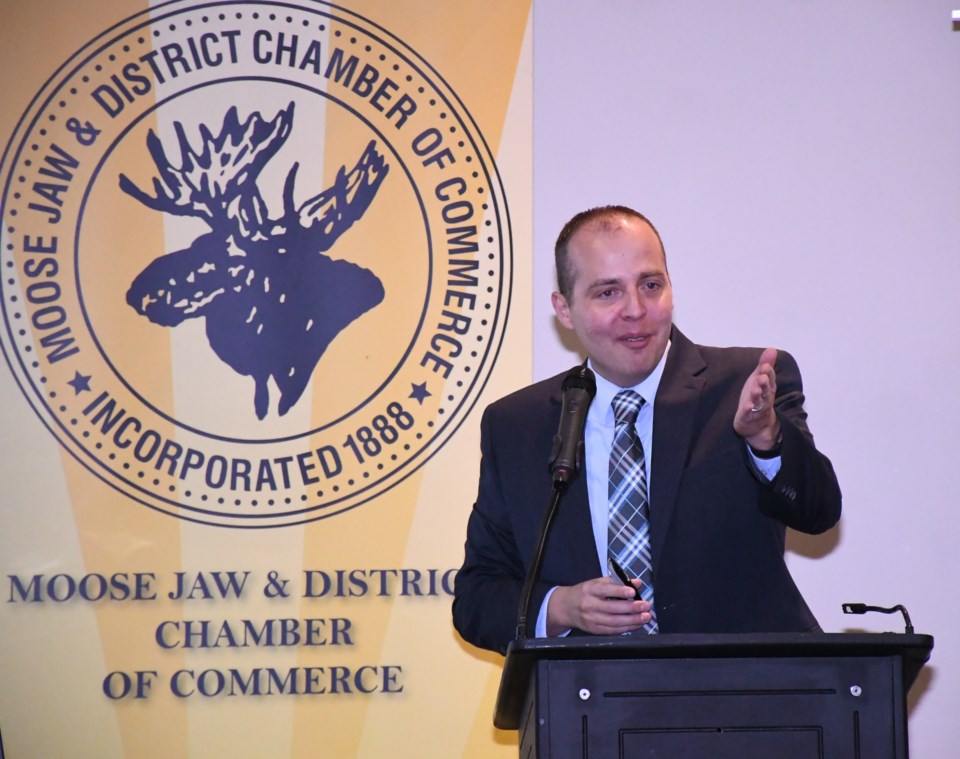Major renovations to the Regina International Airport’s post-security passenger lounge are part of its long-term vision to upgrade almost every area of the complex, the company says.
The airport surveyed its customers last year and asked them what changes they might like to see at the main terminal, explained CEO/president James Bogusz. One idea was for the addition of more services such as food outlets in the passenger lounge.
“When you had your early morning flight, (you) couldn’t get bacon and eggs. You could get a little sandwich and a coffee and a doughnut from (Tim Hortons), but there was nothing of significance post-security,” he said. “And for many of you, if you buy a coffee before security, you can’t walk it through the line. You got to wait until after.”
The airport realigned some walls so more services were available, including the Skyway Restaurant, a full-service Tim Hortons and the Relay gift store, Bogusz said on Oct. 29 during a presentation at the Heritage Inn that the Moose Jaw & District Chamber of Commerce organized.
Established as a non-profit company in 1999, the Regina International Airport (YQR) is the 15th busiest airport in Canada and serves 1.23 million passengers annually.
The change to the post-security area has had a big effect on customers, particularly for people travelling in the morning, Bogusz continued. Travellers now have more time in a low-stress environment to eat and browse the store.
“We’re very proud that those who are travelling through our airport will have much more choice post-security, and we’re looking to grow and build up the various offerings we have, both before the line and after,” he said.
Economic effect
YQR serves southern Saskatchewan and the more than 500,000 residents in the area, Bogusz said. The airport has annual revenues of $28.9 million, is a major economic driver and employer in Regina, and contributes more than $800 million to the local economy.
The airport has three main revenue sources: an airport improvement fee of $20 that is attached to tickets, aviation revenue and non-aviation revenue. The goal is to generate more non-aviation revenue so the company can charge airlines less.
Ground transportation
The airport eliminated a $600 annual fee that it charged to taxis and Uber-style vehicles, and instead, now charges a pay-per-trip fee based on the number of seats per vehicle. Furthermore, long-term parking rates were cut in half; one-week parking is now $89 compared to $105, while two-week parking is $138 compared to $210.
Passenger trends
Since 2008, the number of passengers who have used the Regina International Airport has increased. There were slightly more than one million passengers in 2008, while there were 1.26 million travellers in 2013. However, the airport experienced a decline in growth of four per cent this past year.
“The sky is not falling. It’s a blip. Many Canadian airports are in the same position,” Bogusz said. “But the story of our airport is one of growth, and long term, we, of course, expect to see additional passengers continue using the facility.”
U.S. air service
YQR is well served with airlines travelling to Mexico, but what it lacks are flights from Regina to destinations in the United States, Bogusz said.
United and Delta airlines pulled out several years ago due to the low Canadian dollar. Attempts are being made to attract American Airlines so it can fly from Regina to Denver, Colo. A round-trip flight in a 50-seat plane would generate nearly $12 million a year for YQR.
“We will not rest until this is resolved,” he added.
Meanwhile, Air Canada is adding a third flight to Regina from Vancouver, which is Canada’s second busiest airport. Bogusz believes this route will be successful.
YQR master plan
The goal is to increase passenger growth by 2.8 per cent during the next 20 years, said Bogusz. The airport has plans to ensure the money it generates is well spent. This includes possibly charging less for its airport improvement fee. Furthermore, the main terminal building will change to where passengers will go through security on the main floor instead of the second floor.
The airfield will also see renovations. With more than 2,370.3 metres (7,901 feet) worth of runways, major repairs are regularly needed since the airport authority wants passengers to feel safe travelling.
Environment
YQR is the first airport in Saskatchewan to receive an airport carbon accreditation, a designation that recognizes airports that work to reduce their carbon emissions. As the board considers future capital projects on top of its financial return, said Bogusz, it can look at the reduction of greenhouse gases.
“It’s a nice thing to do,” he added.




